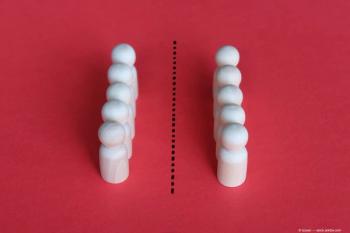
Study zeroes in on new target for treatment of one type of macular degeneration
A team of researchers at the Ohio State University found that in mice an enzyme related to cell growth and division is a culprit in the blood vessel invasion in the back of the eye that causes blurred central vision in wet AMD.
A new study in mice may demonstrate some hope for the development of an eventual alternative treatment option for
According to a news release from the Ohio State University, a team of researchers found that in mice an enzyme related to cell growth and division is a culprit in the blood vessel invasion in the back of the eye that causes blurred central vision in wet AMD.1
In the study, published in Science Direct, researchers found they could target the enzyme, called telomerase, with an experimental drug that suppressed abnormal vascular growth in the animals’ retina.2
Currently, the only treatment for wet AMD is an anti-VEGF injection into the eye.
“Anti-VEGF treatment has shortcomings – after two years, about half of people stop responding. And patients can develop scarring under the retina,” said senior study author Nagaraj Kerur, DVM, PhD, associate professor of Ophthalmology and Visual Sciences at the Ohio State University College of Medicine. “There is a need for better understanding of the mechanisms behind this problem, which, to me, means newer targets need to be tested.”
Dry age-related macular degeneration constitutes about 80% of all AMD cases, and occurs when the macula, a part of the retina, gets thinner, leading to buildup of proteins and cell death, which blur a person’s central vision. Wet AMD, also known as neovascular AMD, is caused by the growth of new blood vessels that invade the retina, a space normally free of vascular activity.1
“You don’t want to have blood vessels there,” said Kerur, who also has a faculty appointment in microbial infection and immunity at Ohio State. “And the blood vessels that invade are often not healthy – they leak their contents and cause inflammation.”
According to the news release, previous cancer research connected high activity of telomerase to rapid production and migration of cells lining blood vessels that enables tumor growth and has also shown the enzyme can stimulate production of VEGF. Based on those findings, Kerur and the research team set out in this work to determine whether telomerase could have a similar damaging effect in the eye.
Choroidal neovascularization (CNV) is the principal driver of blindness in neovascular AMD. Increased activity of telomerase has been associated with endothelial cell proliferation, survival, migration, and invasion in the context of tumor angiogenesis. Expanding on this knowledge,
“We investigated the role of telomerase in the development of choroidal neovascularization (CNV) in mouse model,” researchers wrote in the study. “We observed increased gene expression and activity of telomerase in mouse CNV.”
The researchers also noted in the study that genetic deficiency of the telomerase components, telomerase reverse transcriptase (Tert) and telomerase RNA component (Terc) suppressed laser-induced CNV in mice.2
The researchers tested the effects of an experimental compound that inhibits telomerase activity. By doing this, they were able to demonstrate that the drug lowered telomerase activity in healthy mice and found that injecting it into the eyes of mice with symptoms imitating wet AMD significantly reduced the abnormal blood vessel invasion.
According to the news release, telomerase’s job is to rebuild telomeres, which function as protective caps at the end of chromosomes. Telomeres are known to shorten in many types of cells as a consequence of aging, but Kerur said the study suggested localized blocking of telomerase in the eye had no bearing on the enzyme’s telomere-building function.2
Researchers noted the experimental treatment’s effectiveness at curbing abnormal blood vessel growth in mice was similar to the current anti-VEGF treatment, Kerur said in the news release. Further, the researchers noted that when testing both drugs at lower doses: Individually, a lower dose did not have much of a therapeutic effect, but a combination of both drugs at lower doses gave the best results of all.
“Possibly, one goal would be using a combination therapy rather than one alone,” Kerur said in the news release. “But telomerase inhibition by itself can also be pursued independently, and that is the plan.”
This work was supported by National Institutes of Health grants, the Ohio Lions Eye Research Foundation and a Research to Prevent Blindness grant.1
References:
A new target for treatment of one type of macular degeneration. EurekAlert! Accessed July 8, 2024.
https://www.eurekalert.org/news-releases/1050101 Aman Kumar, Yosuke Nagasaka, Vinodhini Jayananthan, Asmaa Zidan, Tyler Heisler-Taylor, Jayakrishna Ambati, Shigeo Tamiya, Nagaraj Kerur, Therapeutic targeting of telomerase ameliorates experimental choroidal neovascularization, Biochimica et Biophysica Acta (BBA) - Molecular Basis of Disease, Volume 1870, Issue 5, 2024, 167156, ISSN 0925-4439, https://doi.org/10.1016/j.bbadis.2024.167156.
Newsletter
Don’t miss out—get Ophthalmology Times updates on the latest clinical advancements and expert interviews, straight to your inbox.


















































.png)


